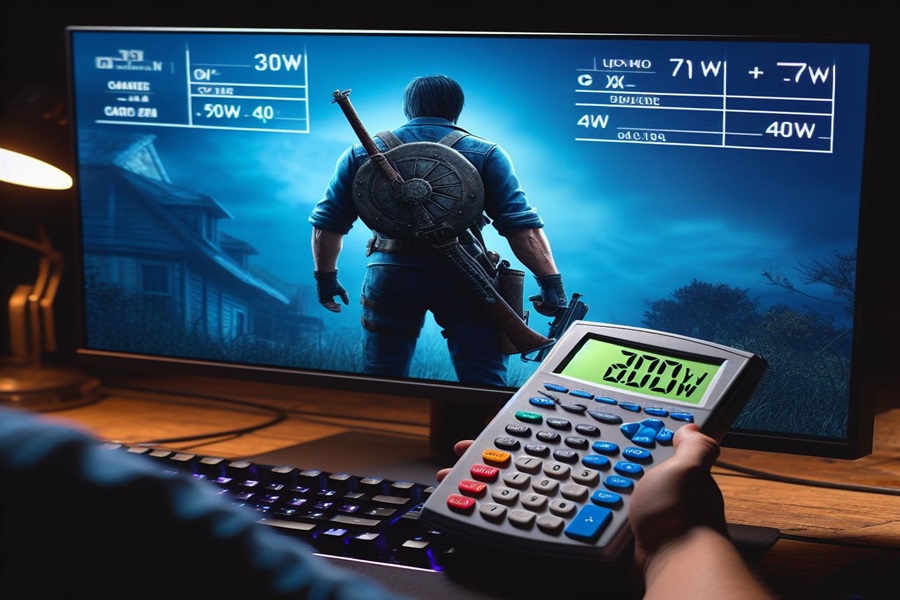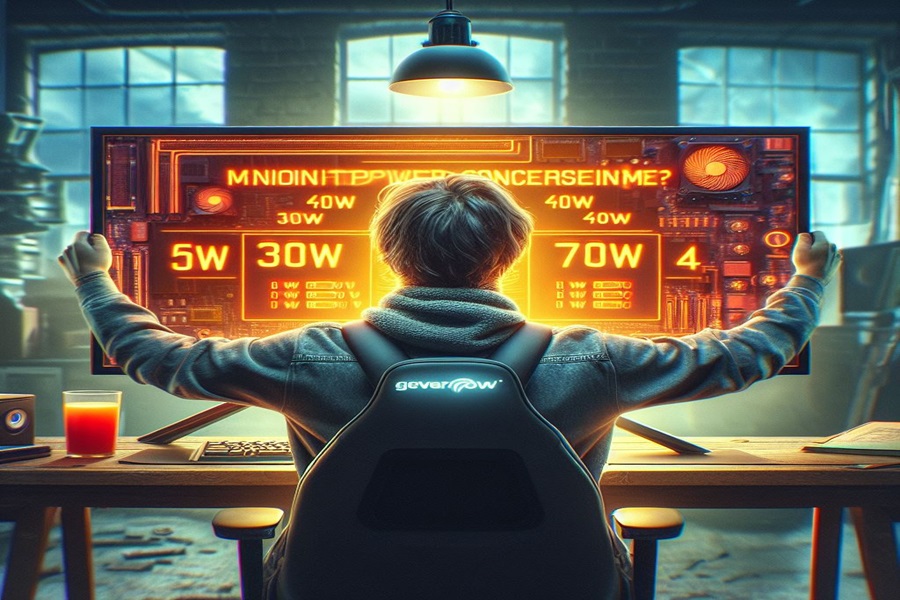
Monitor power consumption refers to the amount of electricity a computer monitor uses. It is measured in watts, with typical monitors ranging from under 30W for 24-27 inch screens up to 50W+ for large 34 inch ultrawide displays. Factors like size, resolution, backlight technology and extra features determine how much power a monitor requires. Checking consumption metrics helps estimate a display’s electricity costs and environmental impact when shopping.
Have you ever wondered how much electricity your computer monitor is using? As energy prices rise and environmental concerns grow, understanding and reducing monitor power consumption is becoming increasingly important. But what exactly is monitor power consumption and how is it measured? This comprehensive guide will explain everything you need to know.
A monitor’s power consumption refers to the amount of electricity it requires to function during normal operation. It’s measured in watts and can range quite a bit depending on the size, resolution, backlight technology, and extra features of the display. Manufacturers provide power consumption metrics on every monitor – both the maximum rated wattage and typical real-world usage.
In this in-depth guide, we’ll break down the key specifics around monitor power use so you can understand where it comes from and how to optimize it. You’ll learn monitor consumption measurements, what good vs bad use looks like, buying considerations around energy efficiency, and tips for reducing your monitor’s electricity demand. Whether your goal is saving money on bills or minimizing environmental impact, this guide will benefit you. Let’s dive in!
- What is Monitor Power Consumption?
- Power Consumption Levels
- What Increases Power Consumption?
- How to Reduce Monitor Power Usage
- Adjust Brightness Setting
- Enable Power-Saving Modes
- Unplug When Not In Use
- Buy ENERGY STAR Certified
- Use Size Appropriately
- Monitor Shopping Considerations
- Check Consumption in Specs
- Compare Energy Efficiency Between Models
- Consider Size and Features You Actually Need
- Look for ENERGY STAR Certified Models
- Check for Eco Modes
- Frequently Asked Questions
- Final Draft
What is Monitor Power Consumption?

Monitor power consumption refers to the amount of electricity a display uses to function normally. It’s measured in watts – the rate of energy transfer equivalent to one joule per second.
A monitor’s power draw depends on a variety of factors including:
- Screen size – Larger monitors need more power to illuminate the entire panel area.
- Resolution – Higher resolutions like 4K or 5K demand more power to drive millions of extra pixels.
- Panel type – More advanced panel types like IPS require more power than basic TN panels.
- Features – Add-ons like USB-C, built-in speakers, HDR increase consumption.
- Efficiency – How much electricity a monitor’s components use compared to output.
Monitor manufacturers provide two main power consumption metrics – rated maximum usage and typical average usage:
- Rated wattage – The peak consumption when testing with active video signal. Represents max potential draw.
- Typical usage – Average real-world usage time for regular consumer tasks. Lower than rated.
Check your monitor’s user manual or specification sheet to find these consumption parameters.
Power Consumption Levels
What constitutes good or bad power consumption depends largely on your monitor’s screen size. Larger displays need more electricity to power up all pixels – so higher wattages are expect. Use the table below as a rough estimate for acceptable consumption by size:
| Monitor Size | Good Consumption | Bad Consumption |
|---|---|---|
| 24-27 inches | <30 watts | >40 watts |
| 32-34 inches | <50 watts | >70 watts |
Factors beyond size such as resolution, panel type and age also impact optimal consumption analysis. Newer monitors with efficient components can use less energy than older ones – even with larger sizes and capabilities.
For example, a 34 inch ultrawide monitor at 3440 x 1440 resolution using a modern IPS panel would fall into the good consumption range at ~50 watts or less. But an old 32 inch 1080p monitor could still use a high ~70+ watts.
What Increases Power Consumption?

Many factors can drive up a monitor’s electricity demands. The main culprits include:
- Screen Size – As covered earlier, larger monitors inherently require more power to illuminate additional surface area.
- Resolution – Higher resolutions mean millions of extra pixels to control. For example, a 4K monitor uses over 8 million pixels versus just 2 million for 1080p. More pixels = more power.
- Brightness Setting – Having brightness above the 65% level can rapidly increase power draw. Keep brightness reasonable to avoid high waste.
- Features/Connectivity – Elements like integrated USB-C, built-in speakers, HDR support can add to the consumption baseline. More capabilities need more electricity.
- Age/Efficiency – Older monitors use more dated, inefficient componentry that wasn’t designed with energy savings in mind. Newer models do more with less power.
LED backlighting has helped curb rising consumption from ever-growing monitor sizes and resolutions. But even the most efficient screens can still use considerable energy if settings aren’t optimized.
How to Reduce Monitor Power Usage
Adjust Brightness Setting
Having brightness set above 65% rapidly increases power draw. Drop to only as bright as needed for your environment.
Enable Power-Saving Modes
Most monitors include preset modes like “Eco” or “Energy Saver” that reduce brightness and limit power drain when idle.
Unplug When Not In Use
If your monitor will be idle for an extended time, unplugging can stop all vampire draw.
Buy ENERGY STAR Certified
ENERGY STAR ratings certify products as energy-efficient, verified through EPA testing. Models with certification generally consume 25% or less energy than standard ones.
Use Size Appropriately
Don’t buy an ultrawide 34″ display if you’ll only run basic web browsing. Size up appropriately for your actual needs.
Properly configuring settings, enabling standby modes, and right-sizing display purchases are key for lowering consumption. Even small adjustments can make a difference.
Now we’ll go through buying factors to consider around energy efficiency when monitor shopping.
Monitor Shopping Considerations
Check Consumption in Specs
When comparing monitor models, inspect technical specifications to find both rated and typical consumption figures. Models with lower wattages generally use less energy.
Compare Energy Efficiency Between Models
Factor power draw into your overall feature and price analysis when deciding on a display. Avoid options with exceptionally high consumption unless necessary for your use case.
Consider Size and Features You Actually Need
Don’t over-purchase on monitor size and capabilities if you won’t utilize them. A 27″ or 32″ screen is likely sufficient for many users without jumping to a power-hungry 34″+ display.
Look for ENERGY STAR Certified Models
ENERGY STAR rating means the model meets strict energy efficiency guidelines verified through EPA testing. Certified monitors generally consume ~25% less power than conventional ones – saving energy and money over time.
Check for Eco Modes
Look if the monitor includes dedicated eco modes or auto brightness adjustment. This allows easy power savings with just a couple setting tweaks.
Frequently Asked Questions
How much power does a monitor use in standby mode?
In standby, most monitors still draw 1-2 watts to maintain network connectivity and allow quick wake. Some models have an ultra low-power mode under 1 watt.
Do bigger monitors use more power?
Yes, larger monitors require more power to illuminate the entire expanded screen area. But screen size isn’t the only factor – higher resolutions and more advanced panel types also increase power needs.
What uses more power – LCD or LED monitors?
Early LCD monitors with cold cathode fluorescent tube (CCFT) backlights used ~2x the power of modern LED-backlit displays. LED backlighting has enabled better energy efficiency.
Should I enable Eco mode to save power?
Yes, Eco modes limit maximum brightness and automatically dim the monitor when not in active use. This can reduce power consumption by up to 25% with minimal effect on visual experience.
Is 4K or 1440p better for lower power consumption?
For a given screen size, 1440p will consume slightly less power than a 4K monitor because it has to power fewer pixels overall. But 4K panels are getting more efficient.
How long do monitors last when unplugged?
When the monitor loses wall power, internal capacitors store just enough residual energy to retain settings/clock for 4 – 8 hours typically. Unplugging essentially resets the monitor.
Final Draft
I hope this detailed guide has helped explain exactly what monitor power consumption represents and how to gauge good versus bad use. The key takeaways around understanding and reducing your monitor’s electricity demands include:
Monitor power consumption is measured in watts, provided in rated maximum and typical figures.
Larger sizes inherently use more power, but factors like resolution and age contribute too.
Enable Eco modes, reduce brightness, and unplug to curb waste. Shop for efficient models like ENERGY STAR to save yearly energy.
Optimizing your monitor not only helps lower your electricity bills – it reduces environmental impacts from fossil fuel-derived energy over the display’s lifespan. Implement even small measures like turning down brightness when possible to make a difference. Together through smart electronic usage, we can achieve true energy conservation.
Akash is a knowledgeable and experienced author at Best PC Monitor. With a keen interest in the latest technology trends, he provides expert insights and analysis on the world of monitors. From reviews to news and comparisons, Akash’s articles are a valuable resource for anyone looking to stay up-to-date on the latest developments in the monitor industry.